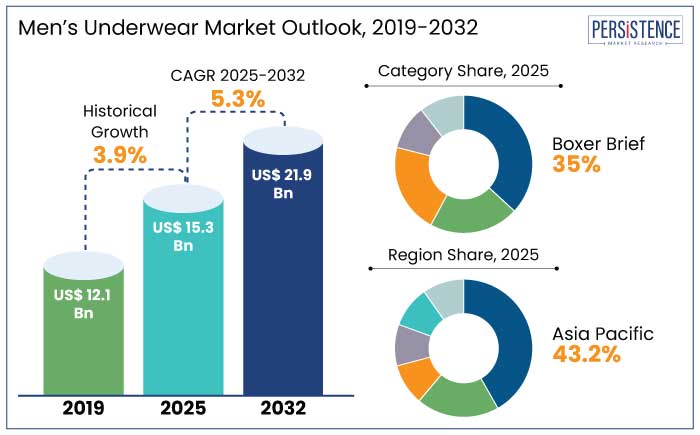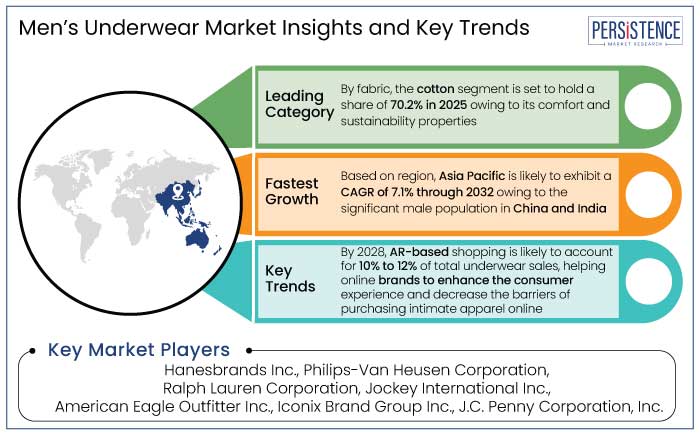Industry: Consumer Goods
Published Date: February-2025
Format: PPT*, PDF, EXCEL
Delivery Timelines: Contact Sales
Number of Pages: 185
Report ID: PMRREP35100
The global men’s underwear market is set to reach a size of US$ 15.3 Bn by 2025. It is anticipated to witness a CAGR of 5.3% during the forecast period to attain a value of US$ 21.9 Bn by 2032.
The market is predicted to witness an increasing demand for activewear-inspired underwear containing athletic and performance-oriented designs. Brands are estimated to focus on breathability, support, and moisture management, particularly for active and on-the-go consumers. By 2028, sports and performance underwear could represent 18% of the total market share, driven by rising trends in fitness and wellness.
Smart underwear with embedded sensors for health monitoring, temperature control, and performance tracking is set to gain popularity during the forecast period. By 2030, the market for smart textiles in underwear could be worth US$ 2 to US$ 3 Bn, driven by the integration of health-monitoring systems such as heart rate and temperature regulation. The advent of biometric-integrated underwear could appeal to health-conscious consumers seeking products that track personal wellness.

Key Highlights of the Industry
|
Market Attributes |
Key Insights |
|
Men’s Underwear Market Size (2025E) |
US$ 15.3 Bn |
|
Projected Market Value (2032F) |
US$ 21.9 Bn |
|
Global Market Growth Rate (CAGR 2025 to 2032) |
5.3% |
|
Historical Market Growth Rate (CAGR 2019 to 2023) |
3.9% |
Asia Pacific is set to hold a share of 43.2% in 2025. The region is home to almost 60% of the global population with a significant male demographic in countries like China, India, Indonesia, and Japan, representing a massive potential customer base for the men’s underwear market. Growth in the middle-class population results in increased disposable income and a greater willingness to spend on premium and branded products.
Men in urban areas are also more likely to adopt modern lifestyles, which emphasize wellness, personal grooming, and hygiene, increasing demand for premium underwear. Growing fitness and wellness trend in Asia Pacific, with an annual fitness market growth of 8.7%, has driven demand for activewear-inspired underwear with moisture-wicking and performance features.
Emerging DTC brands, such as India’s XYXX and China’s Neiwai, are leveraging digital channels to directly reach younger, tech-savvy consumers. This trend aligns with the increasing demand for personalized and subscription-based services.
Boxer brief is projected to generate a share of 35% in 2025. These briefs offer the snug fit and support of briefs, ideal for physical activity, while providing the coverage of boxers, ensuring comfort during daily wear. The added length prevents issues like chafing and riding up, making them suitable for various body types and lifestyles.
Sales of performance-oriented boxer briefs with moisture-wicking and odor-resistant features increased by 22% globally from 2020 to 2023, owing to the global fitness boom. Their seamless and ergonomic design ensures comfort during extended wear, making them a go-to choice for men who seek underwear that transitions well from work to leisure activities.
Cotton is anticipated to generate a share of 70.2% in 2025. Cotton is renowned for its natural softness, making it the most comfortable fabric for sensitive skin and daily wear. This feature is a key reason why 67% of men globally prefer cotton underwear.
Cotton is highly breathable and efficiently absorbs moisture, decreasing sweat buildup and enhancing comfort in warm climates. This is particularly important in tropical regions like Asia Pacific, where demand for breathable fabrics is high. For instance,
As sustainability becomes a key purchasing factor, consumers are increasingly opting for natural and biodegradable materials like cotton. For example,
Potential growth in the global men’s underwear industry is predicted to be driven by advances in technology that result in personalized product offerings, with brands offering custom-fitted underwear based on individual preferences and body types. Personalized shopping experiences are anticipated to increase as brands invest in AI and body measurement technologies.
Performance-focused underwear products are anticipated to drive significant revenue growth, as consumers are willing to pay a premium for comfort, durability, and specialized features. Key innovations will likely include performance fabrics like moisture-wicking, temperature-regulating, and odor-resistant materials, along with eco-friendly options and ergonomic designs that cater to a variety of body types and needs.

The men’s underwear market growth was decent at a CAGR of 3.9% during the historical period. The period witnessed high demand for high-quality, comfortable, and functional underwear, thereby boosting the growth of premium brands, especially in developed markets. Premium men’s underwear accounted for 20% to 25% of the total market in 2023. Comfort and performance features, like moisture-wicking fabrics, anti-odor technology, and seamless designs, became key selling points.
The forecast period is predicted to witness innovations in functionality of men’s underwear. As consumers become more aware of environmental issues, demand for eco-friendly and sustainable products is anticipated to continue to rise. The share of sustainable men’s underwear is anticipated to rise to 30% of total market sales by 2030.
Rising Consumer Base Globally to Bolster Demand
Rising population in emerging markets along with a surging appetite for branded and premium products is fostering demand. The rapidly expanding middle-class populations in India and China are key drivers of growth as they are the significant consumer base for affordable yet stylish underwear brands. For instance,
Urban consumers typically seek premium and innovative products, boosting demand for features like moisture-wicking fabrics and ergonomic designs.
Premiumization Trend to Play a Key Role in Augmenting Sales
In 2023, global disposable income per capita increased by 4.3%, creating room for discretionary spending on luxury and high-quality goods. For instance,
Demand for high-performance fabrics like modal, Supima cotton, and microfibers is on the rise. For example,
Brands like Calvin Klein, Tommy John, and Saxx have built a loyal customer base by focusing on innovative designs and high-quality materials. Nearly 68% of premium underwear buyers stick with their preferred brand due to consistent quality and superior experiences.
Supply Chain Challenges to Remain a Growth Hindering Factor
Uneven supply of raw materials has led to significant disruptions and price volatility. For example,
It resulted in higher production costs for underwear brands, particularly those relying on cotton-based materials.
Modal and other synthetic fibers, which are crucial for performance fabrics, also experience fluctuating prices, exacerbated by the bottlenecks in the global supply chain. These rising costs often result in higher production prices for underwear manufacturers. For instance,
Innovations in Functionality and Design to Create New Growth Prospects
Men are increasingly prioritizing functionality in underwear for diverse activities such as sports, travel, and daily wear. Products with antimicrobial treatments, like those using silver ions or bamboo fibers, have gained immense popularity. Underwear with pouch support and contoured fits address consumer demand for both and aesthetics. For instance,
Brands are also innovating to cater to specific consumer requirements by developing athletic underwear featuring seamless construction, anti-chafing technology, and stretchable materials. They are making travel friendly underwear with quick dying and lightweight option for frequent travelers. Businesses are further innovating climate specific underwear with temperature regulating fabrics like those using Phase-Change Materials (PCM), to cater to consumers in extreme climates.
Emergence of Inclusive and Adaptive Underwear to Create New Opportunities
Traditional ‘one-size-fits-all’ approaches are giving way to extended sizing options, including plus-size and athletic builds.
Brands are hence working toward offering tailored options to suit individual preferences. For instance, companies like Tommy John and Duluth Trading Co. have introduced stretchable and contour-fitting underwear to cater to diverse physiques.
Based on statistics provided by WHO, over 1 billion people worldwide experience some form of disability, making adaptive clothing a critical market segment. Gender-neutral underwear appeals to a broad spectrum of consumers, including LGBTQ+ communities.
Companies in the men’s underwear market are introducing fabrics like moisture-wicking materials, bamboo, and organic cotton for comfort, durability, and sustainability. They are offering ergonomic designs, seamless construction, anti-chafing technology, and pouch-support designs to enhance comfort and functionality.
Brands are also creating niche products like odor-resistant, temperature-regulating, or performance-enhancing underwear for specific needs. They are establishing a distinct brand voice and aesthetic to appeal to target demographics.
Businesses are further highlighting eco-friendly production processes and materials to attract environmentally conscious consumers. They are also partnering with well-known personalities to create buzz and build trust.
Organizations are providing sizing guides, extended size ranges, or even customizable fits to cater to diverse body types. They are offering convenient subscription models for regular replenishments.
Recent Industry Developments
|
Attributes |
Detail |
|
Forecast Period |
2025 to 2032 |
|
Historical Data Available for |
2019 to 2023 |
|
Market Analysis |
US$ Billion for Value |
|
Key Regions Covered |
|
|
Key Market Segments Covered |
|
|
Key Companies Profiled in the Report |
|
|
Report Coverage |
|
|
Customization and Pricing |
Available upon request |
By Fabric
By Category
By Size
By Age Group
By Price Range
By Sales Channel
By Region
To know more about delivery timeline for this report Contact Sales

The market is anticipated to reach a value of US$ 21.9 Bn by 2032.
Boxer shorts are the most popular type of men’s underwear.
Asia Pacific is predicted to hold a share of 43.2% in 2025.
Prominent players in the market include Hanesbrands Inc., Philips-Van Heusen Corporation, and Ralph Lauren Corporation.
The market is predicted to witness a CAGR of 5.3% through the forecast period.